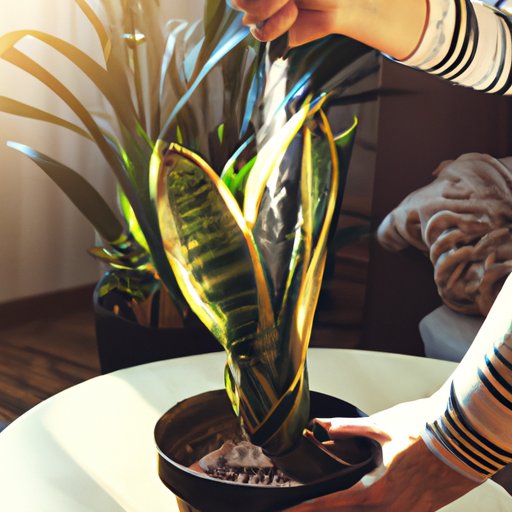Introduction
Taking care of a snake plant is important for keeping it healthy and vibrant. Not only are they easy to maintain, but they also look great in any indoor space. In this article, we’ll discuss the basics of taking care of a snake plant at home. We’ll cover topics such as soil, sunlight, watering, pruning, and fertilizing.
Use Well-Draining Soil to Plant Your Snake Plant
When planting your snake plant, it’s important to use well-draining soil. This will help keep the roots of the plant from becoming waterlogged, which can lead to root rot. A good potting soil mix or cactus and succulent soil mix should work well. Make sure to avoid soils that contain too much organic matter, as this can cause the soil to retain too much moisture.
Choose a pot that has plenty of room for the roots to grow, and fill it up with soil. You don’t need to use too much soil, just enough to cover the roots and provide stability for the plant. Make sure to leave a few inches of space between the top of the soil and the rim of the pot.
Before planting your snake plant, you should prepare the soil by mixing in some perlite or sand. This will help improve drainage and aeration of the soil, which will be beneficial for the plant.
Place it In a Spot That Receives Bright, Indirect Sunlight
Your snake plant should be placed in a spot that receives bright, indirect sunlight. This means placing it near a window that gets plenty of sunlight, but make sure that the direct rays of the sun don’t hit the plant directly. This could cause the leaves to burn.
You can tell if your snake plant is getting too much or too little sunlight by looking at its leaves. If the leaves are yellowing or drooping, then it might be getting too much sunlight. On the other hand, if the leaves are turning pale green or growing slowly, then it might not be getting enough sunlight.
Water Moderately and Make Sure the Soil is Completely Dry Before Watering Again
Snake plants don’t require frequent watering. Instead, wait until the top inch or two of soil is completely dry before watering again. This helps prevent overwatering, which can lead to root rot. It’s best to water your snake plant from the bottom, so that the water can soak into the soil and reach the roots.
To check if the soil is dry, stick your finger into the soil up to the first knuckle. If it feels dry, then it’s time to water. If it still feels moist, then wait a few days before checking again.
If you forget to check the soil and end up watering your snake plant before the soil is completely dry, then you can try to remove the excess moisture by gently squeezing the soil. This will help ensure that the roots don’t become waterlogged.

Prune Off Any Dead Leaves or Stems as Needed
It’s normal for snake plants to lose some of their leaves over time, but if you notice that the plant is losing more than usual, then it may be time to prune off the dead leaves and stems. To do this, simply use a pair of sharp scissors to cut off the dead parts of the plant. Be careful not to damage the healthy parts of the plant while pruning.
You should also check the base of the plant for any dead or decaying leaves. If they are present, then you should remove them immediately to prevent the spread of disease.
Fertilize With a Low-Nitrogen Fertilizer Every Few Months
Snake plants don’t need to be fertilized often, but you can give them a boost every few months with a low-nitrogen fertilizer. This type of fertilizer will help provide the necessary nutrients for the plant to stay healthy and vibrant. Make sure to follow the instructions on the packaging for proper application.
Conclusion
Taking care of a snake plant at home doesn’t have to be difficult. All you need to do is use well-draining soil, place it in a spot that receives bright, indirect sunlight, water moderately and make sure the soil is completely dry before watering again, prune off any dead leaves or stems as needed, and fertilize with a low-nitrogen fertilizer every few months. With the right care, your snake plant will remain healthy and vibrant for years to come.
By following these simple steps, you can keep your snake plant happy and healthy. Not only will it look great in your home, but it will also help purify the air in your home by removing harmful toxins.
(Note: Is this article not meeting your expectations? Do you have knowledge or insights to share? Unlock new opportunities and expand your reach by joining our authors team. Click Registration to join us and share your expertise with our readers.)
